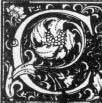 HOME
HOMEEncyclopedia Home Page
C
CA - CALU
CALV - CARS
CART -


Mount Calvary is a small hill or eminence, situated due west from Mount Moriah, on which the Temple of Solomon was built. It was originally a hillock of notable size, but has, in more modern times, been greatly reduced by the excavations made in it for the construction of the Church of the Holy Sepulcher.
There are several coincidences which identify Mount Calvary with the small hill where the "newly made grave", referred to in the Third Degree, was discovered by the weary Brother. Thus, Mount Calvary was a small hill; it was situated in a westward direction from the Temple, and near Mount Moriah; and it was on the direct road from Jerusalem to Joppa, and is the very spot where a weary brother, traveling on that road, would find it convenient to sit down to rest and refresh himself; it was outside the gate of the Temple; it has at least one cleft in the rock, or cave, which was the place which subsequently became the sepulcher of our Lord. Hence Mount Calvary has always retained an important place in the legendary history of Freemasonry, and there are many traditions connected with it that are highly interesting in their import.
One of the traditions is, that it was the burial place of Adam, in order, says the old legend, that where he lay, who effected the ruin of mankind, there also might the Savior of the world suffer, die, and be buried. Sir R. Torkington, who published a pilgrimage to Jerusalem in 1517, says that "under the Mount of Calvary is another chapel of our Blessed Lady and St. John the Evangelist, that was called Golgatha; and there, right under the mortise of the cross, was found the head of our forefather, Adam". Golgotha, it will be remembered, means, in Hebrew, the place of a skull; and there may be some connection between this tradition and the name of Golgotha, by which, the Evangelists inform us, in the time of Christ, Mount Calvary was known. Calvary, or Calvaria, has the same signification in Latin.
Another tradition states that it was in the bowels of Mount Calvary that Enoch erected his nine-arched vault, and deposited on the foundation-stone of Freemasonry that Ineffable Name, whose investigation, as a symbol of Divine truth, is the great object of Speculative Freemasonry. A third tradition details the subsequent discovery of Enoch's deposit, by King Solomon, whilst making excavations in Mount Calvary during the building of the Temple.
On this hallowed spot was Christ the Redeemer slain and buried. It was there that, rising on the third day from his sepulcher, He gave, by that act the demonstrative evidence of the resurrection of the body and the immortality of the soul.
And it is this spot that has been selected, in the legendary history of Freemasonry, to teach the same sublime truth, the development of which by a symbol evidently forms the design of the Third or Master's Degree.
A secret society of gangsters organized about 1820 at Naples. The name is a Spanish word meaning quarrel and similar societies are reported as active in Spain before they were heard of in Italy. From local organized criminals the society grew to revolutionary power in elections and from 1848 exercised a control only broken by the government in 1877. Still powerful in defeat, the municipality of Naples as recently as 1900 was set aside by a Royal Commission.
A double murder in 1911 resulted in the arrest and trial of forty conspirators, several condemned to long imprisonment. The initiation is said to have required the candidate to pick up a coin while the others present struck at it with daggers.
Later there was a fight or duel instead of this. Training of new members lasted three years and at reception the initiate was pledged to loyalty by an oath repeated while his uplifted hand was wet with his own blood. Today the Camorra is curbed, but mysterious crimes in other lands and at home are sometimes credited to its venom (see Carbonari, Mafia, and Secret Societies).
CAMPA portion of the paraphernalia decorated with tents, flags, and pennons of a Consistory of Sublime Princes of the Royal Secret, or Thirty-second Degree of the Ancient and Accepted Scottish Rite. It constitutes the Tracing Board and is worn on the apron of the degree. It is highly symbolic, and represents an imaginary Masonic camp. Its symbolism is altogether esoteric. |
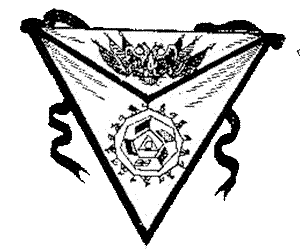 |
CAMPE, JOACHIM HEINRICHA Doctor of Theology, and Director of Schools in Dessau and Hamburg, who was born in 1746 and died October 22, 1818. He was the author of many works on philosophy and education, and was a learned and zealous Freemason, as is shown in his correspondence with Lessing. |
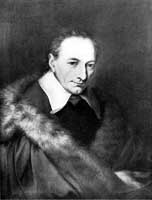 |
Upon the advent of Confederation, July 1, 1867, local control in each Province for the government of the Masonic Fraternity of the Dominion took a strong hold as a predominant idea, and prevailed. Each Province has now a Grand Lodge, and in order of their organization are as follows:
Brother Will H. Whyte, P.G.M., says the first marks of the ancient craftsmen have been found in Nova Scotia a mineralogical survey in 1827 found on the shore of Goat Island in the Annapolis Basin, partly covered with sand, a slab of rock 2½ by 2 feet, bearing on it those well-known Masonic emblems, the Square and Compasses, and the date 1606. Brother Whyte concluded that who were the craftsmen and how the stone came there, must be left to conjecture.
Sojourners Lodge was originally constituted by the Grand Lodge of Scotland in the Republic of Panama. When the Canal Zone was acquired by the Government of the United States of America this Lodge, in 1912, came under the control of the Grand Lodge of Massachusetts in 1912. In 1915 the Canal Zone Lodges were erected into a District Grand Lodge. A treaty was concluded in 1917 between the Grand Lodges of Massachusetts and Panama whereby the former had sole jurisdiction over the Canal Zone. In 1921, the Canal Zone District Grand Lodge comprised six Lodges:
On February 9, 1911, a Dispensation was issued by the General Grand Council to a Council in the Canal Zone at Ancon. This was chartered as Canal Zone Council, No. l, on September 12, 1912. The Grand Encampment of the United States authorized the Canal Zone Commandery, No. l, at Ancon, Panama, on August 14, 1913.
The Ancient and Accepted Scottish Rite was first established here when Panama, No. l, at Cristoal, was constituted a Consistory, a Council of Kadosh, a Chapter of Rose Croix, and a Lodge of Perfection by Charters from the Supreme Council, Southern Jurisdiction, dated October 22, 1915.
An office of high rank and responsibility among the Knights Templar of the Middle Ages, performing the duties of, or similar to, the Chancellor.
An applicant for admission into Masonry is called a candidate. The Latin candidatus means one who is clothed in white, candidis vestibus indutus. In ancient Rome, he who sought office from the people wore a white shining robe of a peculiar construction, flowing open in front, so as to exhibit the wounds he had received in his breast. From the color of his robe or toga candida, he was called candidatus, whence the word candidate. The derivation will serve to remind the Freemason of the purity of conduct and character which should distinguish all those who are candidates for admission into the Order.
The qualifications of a candidate in Freemasonry are somewhat peculiar. He must be free-born-under the English Constitution it is enough that he is a Freeman, under no bondage, of at least twenty-one years of age, in the possession of sound senses, free from any physical defect or dismemberment, and of irreproachable manners, or, as it is technically termed, under the tongue of good report. No atheist, eunuch, or Woman can be admitted. The requisites as to age, sex, and soundness of body have reference to the operative character of the Institution. We can only expect able workmen in able-bodied men.
The mental and religious qualifications refer to the duties and obligations which a Freemason contracts. An idiot could not understand them, and an atheist would not respect them. Even those who possess all these necessary qualifications can be admitted only under certain regulations which differ under the several Masonic Constitutions.
See Advancement, Hurried
Wellins Calcott (see page 172) saw in Freemasonry something more than a museum of Medieval relics, and more than a set of convivial clubs, and undertook to write a rational, or philosophy, on the Craft, becoming thereby the first of a line of greatly distinguished Craftsmen, in which were to stand Hutchinson, Preston, Oliver, Mackey. He was born at a date not discoverable in available books; in the Minutes of one Lodge he is described as "a native of Shrewsbury, county of Salop", in another as from "Salop in Cheshire". At some date in probably the late 1750's he published A Collection of Thoughts, a volume half of quotations and half of his own meditations, a type of book dear to readers in that period. He had 1600 subscriptions for it before printing; and it went through five editions. In 1769 (and with 1200 subscribers) he published A Candid Disquisition of the Principles and Practices of the Most Honorable society of Free and Accepted Masons, etc.
Oliver described this book, so simple, so gentle in spirit, and with few obvious displays of the classical learning behind it, "the gem of the period".
Kenning describes Calcott:
"Indeed he may fully be called the father of the Masonic philosophical and didactic school".
Hughan characteristically valued it because it contained a list of Boston Lodges, as follows:
Calcott was twice in America, both times in the Carolinas, possibly in New York or Boston. He must have been a wandering man, perhaps one of those impracticable, learned men ungifted with the sense of trade or of money, for we can track him in Scotland and England from Lodge to Lodge, going about like a colporteur to distribute his Candid Disquisitions. He was three times in St. David Lodge, No. 30, and became member by affiliation, during 1761 and 1762. Was Worshipful Master of Holywell Lodge, in England. He visited Lodge St. John Kilwinning, Haddington, No. 57, in 1761. He was in Phoenix Lodge, No. 94, in Sunderland, in 1779, when the Minutes describe him as "from Carolina", and gave a Third Degree Lecture. In his Preston Lecture for 1928, John Stokes says:
"Many of the words and phrases used in his lectures were adopted by Hemming and made part of the Ritual which we use today".
It is a romantic fact (and Freemasonry is full of them) that words written down in 1750 or 1760 by this only half-known, gentle, much wandering man, two or three times described in Lodge Minutes as "in unfortunate circumstances", should afterwards be on the tongues of millions of men who have never so much as heard his name !
The golden candlestick of seven branches, which is a part of the furniture of a Royal Arch Chapter, is derived from the holy candlestick which Moses was instructed to construct of beaten gold for the use of the tabernacle.
Smith (Dictionary of the Bible) thus abbreviates Lightfoot's explanation of the description given in Exodus:
"The foot of it was gold, from which went up a shaft straight, which was the middle light. Near the foot was a golden dish wrought almondwise; and a little above that a golden knop, and above that a golden flower. Then two branches one on each side bowed, and coming up as high as the middle shaft. On each of them were three golden cups placed almondwise, in sharp, scallop-shell fashion; above which was a golden knop, a golden flower, and the socket. Above the branches on the middle shaft was a golden boss, above which rose two shafts more, above the coming out of these was another boss and two more shafts, and then on the shaft upwards were three golden scallop-cups, a knop, and a flower, so that the heads of the branches stood an equal height".
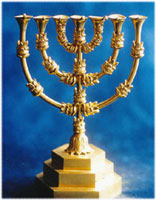
In the tabernacle, the candlestick was placed opposite the table of shewbread, which it was intended to illumine, in an oblique position, so that the lamps looked to the east and south. What became of the candlestick between the time of Moses and that of Solomon is unknown. The first Temple was lighted by ten golden candlesticks similarly embossed, which were connected by golden chains and formed a sort of railing before the veil.
These ten candlesticks became the spoil of the Chaldean conqueror at the time of the destruction of the Temple, and could not have been among the articles afterward restored by Cyrus; for in the second Temple, built by Zerubbabel, we find only a single candlestick of seven branches, like that of the tabernacle. Its form has been perpetuated on the Arch of Titus, on which it was sculptured with other articles taken by that monarch, and carried to Rome as special plunder, spolia opima, after he had destroyed the Herodian Temple. This is the candlestick which is represented as a decoration in a Royal Arch Chapter.
In Jewish symbolism, the seven branches were supposed by some to refer to the seven planets, and by others to the seventh day or Sabbath. The primitive Christians made it allusive to Christ as the Light of the World, and in this sense it is a favorite symbol in early Christian art.
Brother C.C. Hunt, Grand Secretary of Iowa, instructively discussed this subject in the Quarterly Bulletin, January, 1924, and says, in part:
"The use of the seven-branched candlestick in the Most Excellent Degree is correct according to the General Grand Chapter ritual, and has, I believe, an important symbolical reference in the work of that degree.
There is no reason why the seven-branched candlestick should not be used in the Most Excellent Degree as well as in the Royal Arch. It is not necessary to duplicate the elaborate furniture of the Temple in our Most Excellent Degree. The single table and candlestick of the Tabernacle and the second Temple has the same symbolism as the ten of the first Temple. It is true that no symbolic meaning is attached to the candlestick in the ritual, but the very fact that it is used as part of the furniture of the degree indicates that it has the same symbolism there that it had in its place in the Temple, which is, that the seven lights represent the seven planets, which, regarded as the eyes of God, behold everything.
The light in the center signifies the sun, the chief of the planets. The other six planets represented by the three lamps on each side of the central light are Moon, Mercury, Venus, Mars, Jupiter and Saturn. Uranus was first recognized as a planet by Sir William Herschel in 1781 A.D. and the earth was looked upon as receiving light from the planets instead of being considered a planet itself. The seven-branched candlestick was especially holy, and it was forbidden to make copies of it for general purposes.
The fourth chapter of Zechariah gives a symbolical meaning to the seven branched candlestick which is very appropriate to our Chapter work. In fact, part of this very Chapter is quoted in the work of the Degrees. How fitting it is that this candlestick, the symbol of the spirit of the Lord and the light of his countenance shining upon us through his eyes beholding and encouraging us in the noble and glorious work of fitting ourselves as living stones for the spiritual building which is to be our eternal dwelling place, should have a place in the ceremonies of the Most Excellent Master's Degree, the degree which symbolizes the completion of that work and the dedication of the Temple to the service of the only true and living God".
CANNING, GEORGEEnglish statesman and orator, born April 4, 1770; died August 8, 1827; member of Parliament, 1793; Secretary of State for Foreign Affairs, 1807; Prime Minister of England, 1827. Brother Canning was made a Freemason in Prince of Wales Lodge, London, in 1810 (see New Age, August, 1924). |
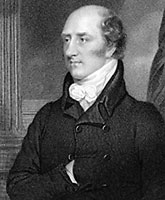 |
Oliver says that in the Masonic processions of the Continent the Grand Master walks under a gorgeous canopy of blue, purple, and crimson silk, with gold fringes and tassels, borne upon staves, painted purple and ornamented with gold, by eight of the oldest Master Masons present; and the Masters of private Lodges walk under canopies of light blue silk with silver tassels and fringes, borne by four members of their own respective companies.
The canopies are in the form of an oblong square, and are in length six feet, in breadth and height three feet, having a semicircular covering. The framework should be of cedar, and the silken covering ought to hang down two feet on each side. This is, properly speaking, a Baldachin (see Baldachin).
Ritualists seem divided in the use of the terms Clouded Canopy and Celestial Canopy in the Entered Apprentice Degree (for the former, see Canopy, Clouded, and Covering of the Lodge). It would seem that the unclouded grandeur of the heavens should not be without advocates. Sir John Lubbock gives the following description of the heavens filled with stars in connection with the latest discoveries:
"Like the sand of the sea, the stars of heaven are used as a symbol of numbers. We now know that our earth is but a fraction of one part of, at least 75,000,000 worlds. But this is not all.
In addition to the luminous heavenly bodies, we cannot doubt there are countless others invisible to us from their great distance, smaller size, or feebler light; indeed, we know that there are many dark bodies which now emit no light, or comparatively tittle. Thus the floor of heaven is not only 'thick , inlaid with patinas of bright gold', but studded also with extinct stars, once probably as brilliant as our own sun".
The clouded canopy, or starry-decked heaven, is a symbol of the Entered Apprentice Degree, and is of such important significance that Lenning calls it a "fundamental symbol of Freemasonry". In the lectures of the York Rite, the clouded canopy is described as the covering of the Lodge, teaching us, as Krause says,
"that the primitive Lodge is confined within no shut up building, but that it is universal, and reaches to heaven, and especially teaching that in every clime under heaven Freemasonry has its seat".
Gädieke says,
"Every Freemason knows that by the clouded canopy we mean the heavens, and that it teaches how widely extended is our sphere of usefulness. There is no portion of the inhabited world in which our labor cannot be carried forward, as there is no portion of the globe without its clouded canopy".
Hence, then, the German interpretation of the symbol is that it denotes the universality of Freemasonry, an interpretation that does not precisely accord with the English and American systems, in which the doctrine of universality is symbolized by the form and extent of the Lodge. The clouded canopy as the covering of the Lodge seems rather to teach the doctrine of aspiration for a higher sphere; it is thus defined in this work under the head of Covering of the Lodge, which see.
A librarian of Dresden, born September 30, 1733, died October 16, 1786. He was an earnest, learned Freemason, who published in a literary journal, conducted by himself and A.G. Meissner at Leipsic, in 1783-5, under the title of Für ältere Litteratur und neuere Lectüre, many interesting articles on the subject of Freemasonry.
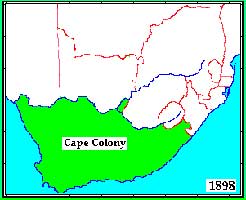
In the days when this district belonged to the Dutch two Lodges were established by them, both of which have had successful careers.
The first of these, Lodge of Good Hope, dates from 1772. The Grand Lodge of England established British Lodge in 1811 and the Athol Grand Lodge followed suit iu 1812 with a Lodge attached to the Tenth Battalion of the Royal Artillery.
The first Lodge erected in 1821 after the arrival of the English colonists was Hope, No. 727. South Africa is divided into Provinces, the Eastern, Western and Central Divisions, Natal and the Transvaal, by the first two of which Freemasonry in Cape Colony is controlled. There are also Provincial Grand Lodges under the Scotch, Irish and Dutch Jurisdictions. Throughout the history of the Colony there has been no antagonism between the Dutch and English Freemasons and many Brethren attend Lodges under both systems. The first Provincial Grand Master under the English Constitution was the Deputy Grand Master of the Netherlands who continued to hold both offices until he died.
CAPE VERDE ISLANDSPraia and St. Vincent each has possessed a Lodge, chartered by the Grand Orient of Portugal. NB: The Cape Verdes are an arrow-shaped archipelago of ten islands in the Atlantic Ocean, the most easterly is about 460km (285 miles) from the coast of Senegal and the most westerly is 830km (515 miles). |
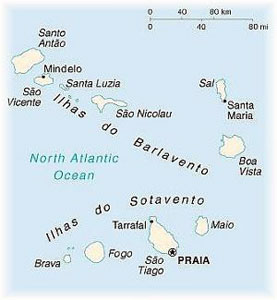 |
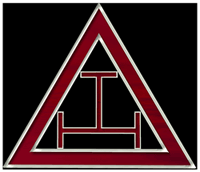
The degrees conferred under the charter of an American Royal Arch Chapter, which are Mark Master, Past Master, Most Excellent Master, and Royal Arch Mason. The Capitular Degrees are almost altogether founded on and composed of a series of events in Masonic history. Each of them has attached to it some tradition or legend which it is the design of the degree to illustrate, and the memory of which is preserved in its ceremonies and instructions. Most of these legends are of symbolic signification. But this is their interior sense. In their outward and ostensible meaning, they appear before us simply as legends.
To retain these legends in the memory of Freemasons appears to have been the primary design in the establishment of the advanced Degrees; and as the information intended to be communicated in these Degrees is of a historical character, there can of course be but little room for symbols or for symbolic instruction; the profuse use of which would rather tend to an injury than to a benefit, by complicating the purposes of the ritual and confusing the mind of the aspirant. These remarks refer exclusively to the Mark and Most Excellent Master's Degree of the American Rite, but are not so applicable to the Royal Arch, which is eminently symbolic. The legends of the second Temple, and the lost word, the peculiar legends of that degree, are among the most prominent symbols of the Masonic system.
The Freemasonry conferred in a Royal Arch Chapter of the York and American Rites. There are Chapters in the Ancient and Accepted, Scottish, and in the French and other Rites ; but the Freemasonry therein conferred is not called capitular.
CAPRIPEDE RATIER ET LUCIFUGEA burlesque dining degree, mentioned in the collection of Fustier. The title is a significant allusion to the goat-footed horned satyrs, minor deities of the Roman mythology, companions of Bacchus, living in the depths of the forest, shunning the light (see Thory, Acta Latomorum,1, 298). NB: Bacchus: Roman God of wine and barley |
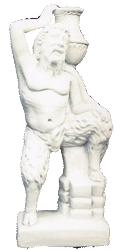 Bacchus |
Or, as it might be called, the cope-stone, the topmost brick or stone in building (but the former word has been consecrated to us by universal Masonic usage), is the topmost stone of a building. To bring it forth, therefore, and to place it in its destined position, is significative that the building is completed, which event is celebrated, even by the Operative Freemasons of the present day, with great signs of rejoicing.
Flags are hoisted on the top of every edifice by the builders engaged in its construction, as soon as they have reached the topmost post, and thus finished their labors. This is the celebration of the capstone - the celebration of the completion of the building - when tools are laid aside, and rest and refreshment succeed, for a time, labor. This is the event in the history of the Temple which is commemorated in the Degree of Most Excellent Master, the sixth in the American Rite. The day set apart for the celebration of the capstone of the Temple is the day devoted to rejoicing and thanksgiving for the completion of that glorious structure.
Hence there seems to be an impropriety in the ordinary use of the Mark Master's keystone in the ceremonies of the Most Excellent Master. That keystone was deposited in silence and secrecy; while the capstone, as the legend and ceremonies tell us, was placed in its position in the presence of all the Craft.
CAPTAIN-GENERALThe third officer in a Commandery of Knights, Templar. He presides over the Commandery in the absence of his superiors, and is one of its representatives in the Grand Commandery. His duties are to see that the Council Chamber and Asylum are duly prepared for the business of the meetings, and to communicate all orders issued by the Grand Council. His station is on the left of the Grand Commander, and his jewel is a level surmounted by a cock or rooster (see Cock). |
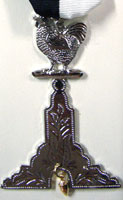 |
CAPTAIN OF THE GUARDThe sixth officer in a Council of Royal and Select Masters. In the latter degree he is said to represent Azariah, the son of Nathan, who had command of the officers of the king's household (First Kings iv, 5). His duties correspond in some measure with those of a Senior Deacon in the primary. degrees. His post is, therefore, on the right of the throne, and his jewel is a trowel and battle-ax within a triangle. |
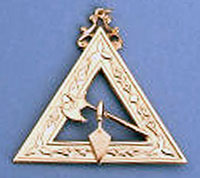 |
CAPTAIN OF THE HOSTThe fourth officer in a Royal Arch Chapter. He represents the general or leader of the Jewish troops who returned from Babylon, and who was called Sar el hatzba, and was equivalent to a modern general. The word Host in the title means army. He sits on the right of the Council in front, and wears a white robe and cap or helmet, with a red sash, and is armed with a sword. His jewel is a triangular plate, on which an armed soldier is engraved. |
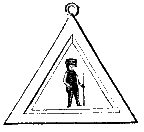 |
The Jews reckoned their national captivities as four:
The present article will refer only to the first, when there was a forcible deportation of the inhabitants of Jerusalem by Nebuzaradan, the general of King Nebuchadnezzar, and their detention at Babylon until the reign of Cyrus, which alone is connected with the history of Freemasonry, and is commemorated in the Royal Arch Degree.
Between that portion of the ritual of the Royal Arch which refers to the destruction of the first Temple, and that subsequent part which symbolizes the building of the second, there is an interregnum or halt, if we may be allowed the term, in the ceremonial of the degree, which must be considered as a long interval in history, the filling up of which, like the interval between the acts of a play, must be left to the imagination of the spectator. This interval represents the time passed in the captivity of the Jews at Babylon. That captivity lasted for seventy years - from the reign of Nebuchadnezzar until that of Cyrus - although but fifty-two of these years are commemorated in the Royal Arch Degree. This event took place in the year 585 B.C. It was not, however, the beginning of the seventy years captivity, which had been foretold by the prophet Jeremiah, which commenced eighteen years before.
The captives were conducted to Babylon. What was the exact number removed we have no means of ascertaining.
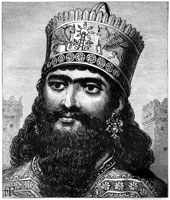
Nebuchadnezzar |
We are led to believe, from certain passages of scripture, that the deportation was not complete. Calmet says that Nebuchadnezzar carried away only the principal inhabitants, the warriors and artisians of every kind, and that he left the husbandmen, the laborers, and in general, the poorer classes, that constituted the great body of the people. Among the prisoners of distinction, Josephus mentions the high priest, Seraiah, and Zephaniah, the priest that was next to him, with the three rulers that guarded the Temple, the eunuch who was over the armed men, seven friends of Zedekiah, his scribe, and sixty other rulers. Zedekiah, the king, had attempted to escape previous to the termination of the siege, but being pursued, was captured and carried to Riblah, the headquarters of Nebuchadnezzar, where, having first been compelled to behold the slaughter of his children, his eyes were then put out, and he was conducted in chains to Babylon. A Masonic tradition informs us that the captive Jews were bound by their conquerors with triangular chains, and that this was done by the Chaldeans as an additional insult, because the Jewish Freemasons were known to esteem the triangle as an emblem of the sacred name of God, and must have considered its appropriation to the form of their fetters as a desecration of the Tetragammaton. |
Notwithstanding the ignominious mode of their conveyance from Jerusalem and the vindictiveness displayed by their conqueror in the destruction of their city and Temple, they do not appear, on their arrival at Babylon, to have been subjected to any of the extreme rigors of slavery. They were distributed into various parts of the empire, some remaining in the city, while others were sent into the provinces.
The latter probably devoted themselves to agricultural pursuits, while the former were engaged in commerce or in the labors of architecture. Smith says that the captives were treated not as slaves but as colonists. They were permitted to retain their personal property, and even to purchase lands and erect houses. Their civil and religious government was not utterly destroyed, for they kept up a regular succession of kings and high priests, one of each of whom returned with them, as will be seen hereafter, on their restoration. Some of the principal captives were advanced to offices of dignity and power in the royal palace, and were permitted to share in the councils of state.
Their prophets, Daniel and Ezekiel, with their associates, preserved among their countrymen the pure doctrines of their religion. Although they had neither place nor time of national gathering, nor temple, and therefore offered no sacrifice, yet they observed the Mosaic laws with respect to the rite of circumcision. They preserved their tables of genealogy and the true succession to the throne of David.
The rightful heir was called the Head of the Captivity. So says the Talmud, but Smith, Dictionary of the Bible, affirms that the assertion is unsupported by proof. The Masonic legends conform to the Talmudic statement. However that may be, Jehoiachin, who was the first king of Judea carried captive to Babylon, was succeeded by his son Shealtiel, and he by his son Zerubbabel, who was the Head of the Captivity, or nominal prince of Judea at the close of the captivity. The due succession of the high priesthood was also preserved, for Jehosadek, who was the high priest carried by Nebuchadnezzar to Babylon, where he died during the captivity, was succeeded by his eldest son, Joshua.
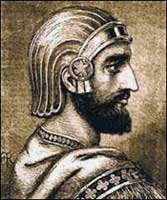 Cyrus |
The Jewish captivity terminated in the first year of the reign of Cyrus, 536 B.C. Cyrus, from his conversations with Daniel and the other Jewish captives of learning and piety, as well as from his perusal of their sacred books, more especially the prophecies of Isaiah, had become imbued with a knowledge of true religion, and hence had even publicly announced to his subjects his belief in the God "which the nation of the Israelites worshipped". He was consequently impressed with an earnest desire to fulfil the prophetic declarations of which he was the subject, and to rebuild the Temple of Jerusalem. Cyrus therefore issued a decree by which the Jews were permitted to return to their country. According to Milman, 42,360, besides servants, availed themselves of this permission, and returned to Jerusalem under Zerubbabel, their prince, and Joshua, their high priest, and thus ended the first or Babylonian captivity, the only one which has any connection with the legends of Freemasonry as commemorated in the Royal Arch Degree. |
CAPUCHINOne of the monks of the order of St. Frances. They went barefoot, were long bearded, and wore a gown or cloak of dark color made like a woman's garment with a hood. |
 |
A Roman emperor, who assumed the purple 287 A.D. Of him Preston gives the following account, which may or may not be deemed apocryphal, according to the taste and inclination of the reader:
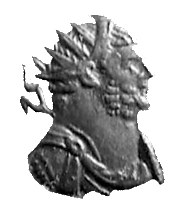
"By assuming the character of a Freemason, he acquired the love and esteem of the most enlightened part of his subjects. He possessed real merit, encouraged learning and learned men, and improved the country in the civil arts. In order to establish an empire in Britain, he brought into his dominions the best workmen and artificers from all parts; all of whom, under his auspices, enjoyed peace and tranquillity. Among the first class of his favorites he enrolled the Freemasons: for their tenets he professed the highest veneration, and appointed Albanus, his steward, the principal superintendent of their assemblies. Under his patronage, Lodges and Conventions of the Fraternity were formed, and the rites of Freemasonry regularly practiced. To enable the Freemasons to hold a general council, to establish their own government and correct errors among themselves, he granted to them a charter, and commanded Albanus to preside over them in person as Grand Master" (see Illustrations, edition of 1812, page 142).
Anderson also gives the legend of Carausius in the second edition of his Constitutions, and adds that "this is asserted by all the old copies of the Constitutions, and the old English Masons firmly believed it" (Constitutions, 1738, page 57). But the fact is that Anderson himself does not mention the tradition in his first edition, published in 1723 nor is any reference to Carausius to be found in any of the old manuscripts now extant. The legend is, it is true, inserted in Krause's Manuscript; but this document is of very little authority, having been, most probably, a production of the early part of the eighteenth century, and of a contemporary of Anderson, written perhaps between 1723 and 1738, which would account for the omission of it in the first edition of the Book of Constitutions, and its insertion in the second.
The reader may hence determine for himself what authenticity is to be given to the Carausian legend.
The name in Italian means Charcoal Burners, applied to some revolutionary secret societies particularly active in Italy and France, having their principal inspiration during the reign of King Joachim Murat of Naples, and aiming to free themselves from foreign rule and establish democratic government. Murat, a Frenchman and a Freemason, the dashing cavalry leader of Napoleon's army, was rewarded with the throne.
Luigi Villari says (Encyclopedia Britannica):
A suggestion and admission meaning little more than similarity, both being secret societies. However, the Carbonari had its significant words:
|
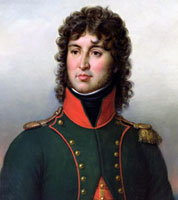 King Joachim Murat of Naples |
The ritual had four grades and the ceremonies had typical allusions, as "clearing the forest of wolves" was said to be the aim, and there were references to the lamb torn by wild animals, tyranny. Carbonarism was declared high treason by 1821. While many prominent persons were members, Lord Byron of England and Louis, afterwards Napoleon III, of France, yet the strength of the movement waned and died in France about 1830, and soon afterwards a like end came to it in Italy, the Camorristi in the former country accepting generally the government then at work, and in the latter instance associating with Mazzini and his followers (see Camorra, Mafia, and Secret Societies).
In Hebrew, baw-rek-ath, the third stone in the first row of the high priest's breastplate, according to the authorized version, but the first stone in the second row, according to the Septuagint. Braun, a writer on the sacerdotal vestments of the Hebrews, Amsterdam, 1680 supposes that the baw-rek-ath was a smaragdus or emerald, which view is sustained by Kalisch, and is in accordance with the Septuagint translation. The Talmudists derive baw-rek-ath from a word signifying to shine with the brightness of fire, which would seem to indicate some stone of a coruscate or sparkling color, and would apply to the bright green of the emerald as well as to the bright red of the carbuncle. The stone, whatever it was, was referred to the tribe of Judah.
The carbuncle in Christian iconography signifies blood and suffering, and is symbolical of the Lord's passion. Five carbuncles placed on a cross symbolize the five wounds of Christ.
The North, West, East and South are so called from the Latin cardo, meaning a hinge, because they are the principal points of the compass on which all the others hinge or hang.
Each of them has a symbolic signification in Freemasonry which will be found under their respective heads. Doctor Brinton, in an interesting Treatise on the Symbolism and Mythology of the Red Race of America, has a chapter on the sacred number four; the only one he says, that has any prominence in the religious of the red race, and which he traces to the four cardinal points. The reason, he declares, is to be "found in the adoration of the cardinal points", and he attributes to this cause the prevalence of the cross as a symbol among the aborigines of America, the existence of which so surprised the early missionaries that they "were in doubt whether to ascribe the fact to the pious labors of Saint Thomas or the sacrilegious subtlety of Satan".
The arms of the cross referred to the cardinal points, and represented the four winds, the bringers of rain. The theory is an interesting one, and the author supports it with many ingenious illustrations. In the symbolism of Freemasonry each of the cardinal points has a mystical meaning. The East represents Wisdom ; the west, Strength; the South, Beauty and the North, Darkness.
The pre-eminent or principal virtues on which all the others hinge or depend.
They are temperance, fortitude, prudence, and justice.
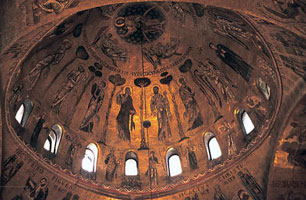
They are referred to in the ritual of the Entered Apprentice Degree, and will be found in this work under their respective heads. Oliver says (Revelations of a Square, chapter 1) that in the eighteenth century the Freemasons delineated the symbols of the four cardinal virtues by an acute angle variously disposed.
Thus, suppose you face the east, the angle symbolizing temperance will point to the south. It was called a Guttural.
Fortitude was denoted by a saltire, or Saint Andrew's Cross, X. This was the Pectoral.
The symbol of prudence was an acute angle pointing toward the southeast, and was denominated a Manual; and justice had its angle toward the north, and was called a Pedestal or Pedal.
The possession of cardinal virtues is no special distinction of Freemasons, for other societies have had them.
They are in evidence in the Christian church.
The fifteen cardinal virtues, in mosaic, in the dome of Ascension of Saint Mark's at Venice is a famous example. (Pictured above).
|
A name sometimes applied to the whole of the West Indies, strictly comprising only the chain of islands from Porto Rico to the Venezuelan coast of South America. Three Lodges were at work in 1739 at Antigua. Others had been chartered and were on the Grand Lodge Books but they had ceased to exist and were dropped from the Register. In 1738 Governor Matthews was appointed by the Grand Lodge of England Provincial Grand Master of the Leeward Islands. A Masonic Province was also established by Scotland in 1769. A Provincial Grand Lodge was opened at the Windward Islands in 1740 and Brother Thomas Baxter was first Provincial Grand Master. In the same year the "Moderns" Grand Lodge of England authorized Lodge No. 186. The Grand Lodge of Ireland established another Provincial Grand Lodge at Barbados, but it was soon abandoned. A Lodge, Albion, was opened at Bridgetown, Barbados, in 1790 by the "Ancient" and it remained in existence although three others warranted by the same authority soon ceased work. Other Lodges were chartered in the Islands by the Grand Lodges of England, Holland, France, Pennsylvania, etc. |
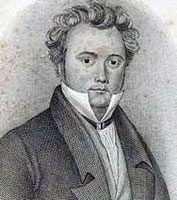
A printer and bookseller of London, who in 1819 was fined and imprisoned for the publication of Paine's Age of Reason, and Palmer's Light of Nature.
He also wrote and published several pretended expositions of Freemasonry, which, after his death, were collected, in 1845, in one volume, under the title of a Manual of Freemasonry, in three parts.
Carlile was a professed atheist, and, although a fanatical reformer of what he supposed to be the errors of the age, was a man of some ability.
His Masonic works are interspersed with considerable learning, and are not as abusive of the Order as expositions generally are. He was born in 1790, and died in 1843, in London. For ten years before his death his religious opinions had been greatly modified.
Monks of an Order established on Mount Carmel, in Syria, during the twelfth century. They wore a brown scapular passing over the shoulder and diagonally across the back and body, thus crossing the gown from right to left.
NB: scapular: a sleeveless outer garment falling from the shoulders.
Grand Master of England, March, 1754, to May 18, 1757. Afterwards known as Duke of Chandos.
An organized body in Holland and Belgium, with central point of assembly at Antwerp. Their gatherings were at night in some neighboring forest.
The chart or Tracing Board on which the emblems of a degree are depicted for the instruction of a candidate.
Carpets were originally drawn on the floor with chalk or charcoal, and at the close of the Lodge obliterated by the use of a mop and pail.
To avoid this trouble, they were subsequently painted on cloth, which was laid on the floor ; hence they were called carpets.
Carpets, or charts, as they are at the present time commonly designated, are now generally suspended from the wall, or from a framework in the Lodge (see Steps on Master's Carpet).
Initiated in 1846 and became Past Master of Cynthia Lodge No. 155, as well as founder and First Worshipful Master of Kilwinning Lodge, No. 356, warranted in 1865, both Lodges being at Cincinnati, Ohio, and he was active and scholarly in all branches of the Fraternity. He printed at his own expense several important works of interest and value to the Fraternity.

The first facsimile of the Book of Constitutions of 1723 was published by him in 1855 from the copy in his own library and in the same year he had a catalog of his collection printed in the American Freemason at Louisville.
Doctor Oliver's Historical Landmarks was also issued in like manner in 1855.
He established the Masonic Archeological Society, of which he was really the whole organization and mainspring and which did good work, producing the very rare works, the Grand Mystery of 1724 and Prichard's Masonry Dissected, of 1730, and publishing them in 1868.
Eight years later, what is known as Mrs. Dodds Manuscripts of 1739 was issued. In 1889 an artistic facsimile reproduction of the very valuable engraved list of 1736 by Pine was published by him and from 1872 he was at work on the production of a sumptuous catalog of his Masonic library, which was begun in the Masonic Review of Cincinnati and then reprinted in book form from 1874.
It was not completed, however, much to the regret of his many friends, the important bibliography ending with No. 1134 Picart, pages 1 to 224.
Brother Carson also wrote and published much other material respecting the Craft, and, as with the previously mentioned books, all was at his own expense; the whole of the works being presented to his literary friends and Brethren.
He died on February 23, 1899.
His fine library is now, through the generosity of General Lawrence, possessed by the Grand Lodge of Massachusetts.
Famous American scout, born in Madison County, Kentucky, December 24, 1809. In his childhood, his parents moved to Missouri.
Carson became guide and hunter, accompanied the Fremont expeditions, took part in the Mexican War, and become Indian Agent at Taos, New Mexico, in 1854.
Made a Master Mason on December 26, 1854, in Montezuma Lodge at Santa Fe, in what was then a Territory but is now the State of New Mexico, Montezuma Lodge was No. 109 on the roster of the Grand Lodge of Missouri and was one of the Lodges organizing the Grand Lodge of New Mexico in 1877.
He demitted from this Lodge on April 30, 1860, but affiliated again a few years later and remained a member until his death which occurred, May 24, 1868, at Santa Fe, New Mexico. The Grand Lodge of Arizona has taken charge of the grave lot and the monument which was erected to this early American, pioneer (see also New Age Magazine, May, 1925).
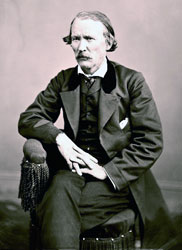 |
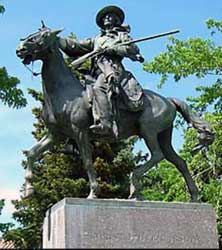 |
Kit Carson Statue |